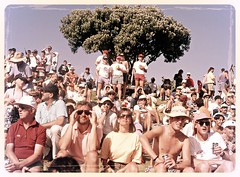Taking a leaf out of this
Baltimore map by Burgersub illustrating what that city's underground network might look like if every Subway sandwich shop was actually a subway station, here's my attempt at replicating the same idea for Auckland. Did you know there are 94 Subways in Auckland? Of course I knew they were ubiquitous, but I didn't realise there were nearly a hundred of them. Wonder if they'll still be a fixture in five or 10 years time, or whether they'll go the way of Georgie Pie and the almost-vanished Cobb & Co? You'll need to zoom in or maximise the map view to get a decent look at the nine lines.
There are a few caveats on this map, of course. It's meant to be a bit of fun and not a serious plan for an underground network. Auckland clearly lacks the 10 or so million population required to justify a system of this size. I've left out the shop in Warkworth in the far north (sorry Warkworth!) because they were a long way out and I didn't want to get fiddly with the Google Maps line-drawing interface. I've also changed a few of the names of the shops from the
Subway store finder, to make them sound a little more like underground stations that are representative of the neighbourhood they serve.
If I find time to draw up proper transit maps I'll post them here, but in the meantime, here's a list of the lines and stations:
LINE 1 (Dark Blue) - Kumeu to Howick via Queen St, Newmarket & Onehunga
Kumeu, Westgate, Te Atatu North, Rosebank Rd, Unitec, Grey Lynn, Ponsonby, Victoria Park, Victoria St West, Queen St, Vector Arena, Quay St, Parnell Rise, Newmarket North, Newmarket Broadway, Newmarket South, Royal Oak, Onehunga (Dress-Smart), Te Papapa, Sylvia Park, Pakuranga, Highland Park, Howick.
LINE 2 (Yellow) - Britomart to Auckland International Airport via Newmarket, Onehunga & Mangere
Britomart, Fort St, Queen St, Midcity, St James, Symonds St (University), Auckland Hospital, Newmarket Broadway, Ellerslie, Penrose, Onehunga, Mangere Bridge, Mangere, Auckland Domestic, Auckland International.
LINE 3 (Dark Green) - Albany to Lynfield via Takapuna, Devonport, Queen St & Mt Eden
Albany Westfield, Albany Mercari Way, William Pickering Dr, Glenfield (Westfield), Smales Farm Park, Takapuna, Devonport, Quay St, Vector Arena, Queen St, Victoria St West, K Rd, Kingsland, Dominion Rd (Eden Park), Mt Roskill, Stoddard Rd, Lynfield.
LINE 4 (Red) - Orewa to Glen Innes via North Shore, Queen St, Newmarket & Ellerslie
Orewa, Whangaparaoa, Northcross, Millennium, Constellation Dr, Wairau Park, Wairau Valley, Smales Farm Park, AUT North Shore, Fanshawe St, Victoria Park, Midcity, Stanley St (Tennis Centre), Parnell Rise, Newmarket North, Newmarket Broadway, Ellerslie, Mt Wellington, Glen Innes.
LINE 5 (Orange) - Te Atatu North to Newmarket via New Lynn & St Lukes
Te Atatu North, Lincoln North, Lincoln Rd, West Plaza, Kelston, Titirangi, New Lynn, St Lukes (Westfield), Dominion Rd, Mt Eden, Newmarket Broadway.
LINE 6 (Purple) - Glen Innes to Auckland International Airport via Botany & Manukau
Glen Innes, Highland Park, Botany Northpark, Botany Town, Flatbush, Manukau (Westfield), Lambie Dr, Auckland Domestic, Auckland International.
LINE 7 (Light Green) - Viaduct Basin to Bombay or Waiuku via Newmarket, Sylvia Pk & Papakura
Viaduct Basin, Britomart, Vector Arena, Quay St, Parnell Rise, Newmarket North, Newmarket Broadway, Ellerslie, Mt Wellington, Sylvia Park, Otahuhu, Papatoetoe, Manukau (Westfield), Manukau Events Centre, Manurewa, Takanini, Papakura, Great South Rd, and then either terminating at Bombay or Waiuku via Pukekohe.
LINE 8 (Light Blue) - Unitec to Clendon Pk via Mt Roskill, Sylvia Pk & Manukau
Unitec, St Lukes (Westfield), Mt Roskill, Royal Oak, Penrose, Sylvia Park, Highbrook, East Tamaki, Flatbush, Manukau (Westfield), Manukau Events Centre, Manurewa, Clendon Park.
LINE 9 (White) -
Browns Bay to Highbury shops in Birkenhead via Albany
Browns Bay, Northcross, Oteha Valley, Albany (Westfield), Albany Mercari Way, William Pickering Dr, Glenfield (Westfield), Highbury
See also:
Blog:
Avondale to Onehunga tramlink, 31 October 2010
Blog:
Christchurch commuter rail, 20 October 2010
Blog:
New trams for Auckland?, 27 June 2010









